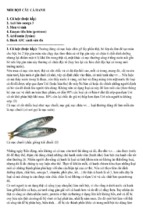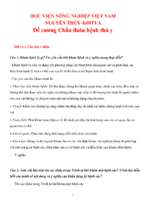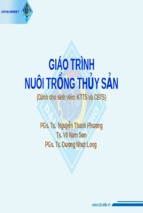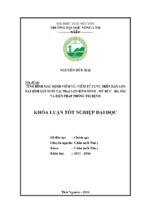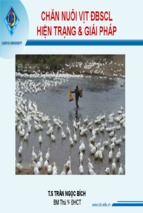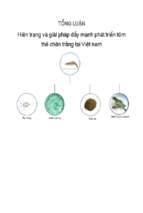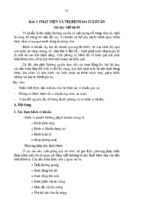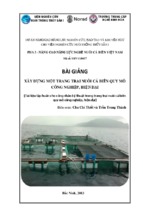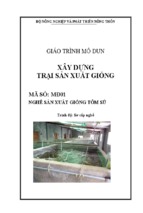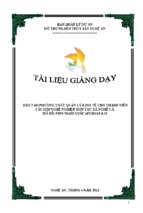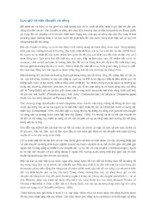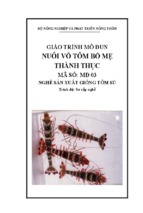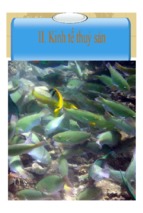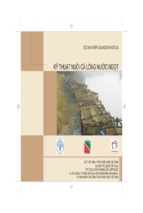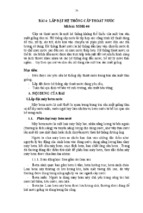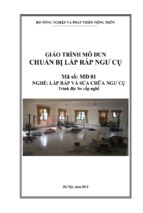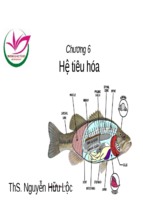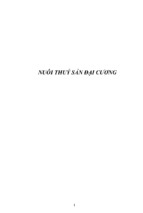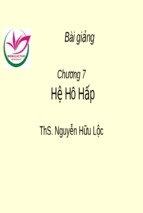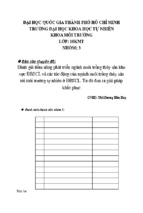ABSTRACT
Aquaculture has grown rapidly as the world’s wild-caught fisheries approach their
sustainable limits. Feed conversion in aquaculture is more efficient than in terrestrial
animals. Thus with a growing world population, seafood produced through aquaculture
can provide a high quality source of protein. Aquaculture systems rely on high stocking
densities and commercial feeds to increase production and profitability, which increase
animal stress and susceptibility to disease. Veterinary drugs are commonly used to
prevent and treat disease outbreaks. Several of these drugs are banned for use in
shrimp farming in the United States. These drugs can be toxic to humans, with side
effects that can be fatal. There is also an increased risk of developing antibiotic resistant
strains of human pathogens, including Bacillus and Vibrio species. The Food and Drug
Administration is responsible for the safety of all fish and fishery products entering the
United States, but funding for testing is limited. Examples of drugs with high
enforcement priority include chloramphenicol, nitrofurans, fluoroquinolones and
quinolones, malachite green, and steroid hormones. State testing has repeatedly
resulted in the detection of banned drugs. The objective of this study was to quantify
veterinary drug residues in commercially available frozen shrimp.
Imported, farm-raised shrimp samples were purchased from local supermarkets
and include shrimp from seven brands and six different countries. A preliminary
screening was done using rapid ELISA kits to test for chloramphenicol, malachite green,
nitrofurans, and fluoroquinolones. Samples tested positive for malachite green and
fluoroquinolones; all samples tested negative for chloramphenicol and nitrofurans.
ELISA results were confirmed using liquid chromatography with tandem mass
DETECTION AND CONFIRMATION OF VETERINARY DRUG RESIDUES
IN COMMERCIALLY AVAILABLE FROZEN SHRIMP
A Thesis
Submitted to the Graduate Faculty of the
Louisiana State University and
Agricultural and Mechanical College
in partial fulfillment of the
requirements for the degree of
Master of Science
in
The School of Nutrition and Food Sciences
by
Jessica Danielle Johnson
B.S., Louisiana State University, 2012
May 2014
Dedicated to my parents, Lisa and Jason Johnson.
ii
ACKNOWLEDGEMENTS
I have been so blessed to have the opportunity to gain valuable knowledge and
experience throughout my graduate studies, and it is with immense gratitude that I
acknowledge those who helped me along the way. I would first like to thank my advisor,
Dr. John Finley, for everything he has taught me, the opportunities he has provided, and
for inspiring confidence in me. I am sincerely grateful to Dr. Jack Losso, for being the
first person to persistently encourage me to pursue my graduate education. I would like
to thank Dr. Jimmy Xu, for his technical support and helpful advice. The wisdom,
kindness, and encouragement of the food science faculty and staff have been
invaluable, with a special thanks to Mrs. Terri Gilmer, for being my LSU mom for the last
seven years.
I am exceedingly grateful for the people I have spent this journey with. To my
best friend, Sara Black – thank you, for everything. Thank you to my labmates,
classmates, friends, to Shakers and Bakers, and to our research group. I feel so lucky
to have you all in my life. And to Samantha Stein, who was there with me from the
beginning, and gets it. I am also truly grateful for my dear friends, Victoria Holubar and
Briana Schwartz, for always being there for me and keeping me grounded. I will be
forever appreciative of the unfailing love and support of my family. I would like to
express my deep gratitude to my parents, my grandparents, Ronnie Cavalier and Sarah
and Dallas Johnson, and my three sisters, Ashley, Amber, and Jacey, whom I love
unconditionally. Finally, I would like to thank two people who have profoundly influenced
my life: Ouida Lynn Cavalier, who taught me the value of education, happiness, and
helping others, and Walter Henry Wascom, who taught me when to just forget about it.
iii
TABLE OF CONTENTS
ACKNOWLEDGEMENTS................................................................................................ iii
LIST OF TABLES ............................................................................................................. v
LIST OF FIGURES .......................................................................................................... vi
ABSTRACT .................................................................................................................... vii
CHAPTER 1. LITERATURE REVIEW .............................................................................. 1
1.1 Introduction ............................................................................................................. 1
1.2 Shrimp Aquaculture ................................................................................................ 2
1.3 Veterinary Drug use in Shrimp Aquaculture ........................................................... 5
1.4 Impact on the Environment and Human Health ...................................................... 7
1.4.1 Environmental Impacts ..................................................................................... 7
1.4.2 Antimicrobial Resistance .................................................................................. 8
1.4.3 Residues of Food Safety Concern ................................................................... 9
1.4.4 Chloramphenicol ............................................................................................ 10
1.4.5 Fluoroquinolones ............................................................................................ 11
1.4.6 Malachite Green ............................................................................................. 12
1.4.7 Nitrofurans ...................................................................................................... 13
1.5 Alternatives to Antibiotics in Aquaculture Disease Management .......................... 14
1.6 Laws and Regulations for Veterinary Drug Use in Aquaculture ............................ 16
1.6.1 International Regulations ............................................................................... 16
1.6.2 United States Regulations .............................................................................. 17
CHAPTER 2. MATERIALS AND METHODS ................................................................. 19
2.1 Sample Procurement ............................................................................................ 19
2.2 ELISA Screening .................................................................................................. 19
2.2.1 Chloramphenicol ............................................................................................ 20
2.2.2 Fluoroquinolones ............................................................................................ 20
2.2.3 Malachite Green ............................................................................................. 21
2.2.4 Nitrofurans ...................................................................................................... 22
2.3 Liquid Chromatographic–Mass Spectrometric Confirmation of Residues ............ 23
2.3.1 Chloramphenicol and Enrofloxacin Quantitation ............................................ 23
2.3.2 Malachite Green Quantitation ........................................................................ 25
CHAPTER 3: RESULTS AND DISCUSSION ................................................................. 27
3.1 Detection and Confirmation of Drug Residues ..................................................... 27
3.2.1 Chloramphenicol ............................................................................................ 29
3.2.2 Fluoroquinolones ............................................................................................ 32
3.2.3 Malachite Green ............................................................................................. 35
3.2.4 Nitrofurans ...................................................................................................... 36
CHAPTER 4. SUMMARY AND CONCLUSIONS ........................................................... 39
REFERENCES ............................................................................................................... 41
THE VITA ....................................................................................................................... 46
iv
LIST OF TABLES
Table 3.1. Veterinary drugs analyzed, detection limits of methods used (ppb), and
current FDA detection levels (ppb) ................................................................................. 27
Table 3.2: Concentration of veterinary drugs (ppb) in shrimp as detected by ELISA ..... 29
Table 3.3: Cross-reactivity profile for chloramphenicol ELISA ....................................... 30
Table 3.4: Cross-reactivity profile for fluoroquinolone ELISA ......................................... 33
Table 3.5: Cross-reactivity profile for chloramphenicol ELISA ....................................... 35
Table 3.6: Concentration of veterinary drugs (ppb) in shrimp as detected by ELISA
and confirmed using LC-MS/MS .................................................................................... 37
v
LIST OF FIGURES
Figure 1.1: Chemical structure of chloramphenicol ........................................................ 10
Figure 1.2: Chemical structures of enrofloxacin and primary metabolite ciprofloxacin .. 11
Figure 1.3: Chemical structures of malachite green and primary metabolite
leucomalachite green ..................................................................................................... 12
Figure 1.4: Chemical structures of furaltadone and primary metabolite 3-amino-5morpholinomethyl-2-oxazolidinone ................................................................................. 13
Figure 3.1: Extracted ion chromatogram for chloramphenicol in sample 1 .................... 31
Figure 3.2: Extracted ion chromatogram for chloramphenicol in sample 2 .................... 31
Figure 3.3: Extracted ion chromatogram for chloramphenicol in sample 4 .................... 32
Figure 3.4: Extracted ion chromatogram for enrofloxacin in sample 2 ........................... 34
Figure 3.5: Extracted ion chromatogram for enrofloxacin in sample 3 ........................... 34
vi
ABSTRACT
Aquaculture has grown rapidly as the world’s wild-caught fisheries approach their
sustainable limits. Feed conversion in aquaculture is more efficient than in terrestrial
animals. Thus with a growing world population, seafood produced through aquaculture
can provide a high quality source of protein. Aquaculture systems rely on high stocking
densities and commercial feeds to increase production and profitability, which increase
animal stress and susceptibility to disease. Veterinary drugs are commonly used to
prevent and treat disease outbreaks. Several of these drugs are banned for use in
shrimp farming in the United States. These drugs can be toxic to humans, with side
effects that can be fatal. There is also an increased risk of developing antibiotic resistant
strains of human pathogens, including Bacillus and Vibrio species. The Food and Drug
Administration is responsible for the safety of all fish and fishery products entering the
United States, but funding for testing is limited. Examples of drugs with high
enforcement priority include chloramphenicol, nitrofurans, fluoroquinolones and
quinolones, malachite green, and steroid hormones. State testing has repeatedly
resulted in the detection of banned drugs. The objective of this study was to quantify
veterinary drug residues in commercially available frozen shrimp.
Imported, farm-raised shrimp samples were purchased from local supermarkets
and include shrimp from seven brands and six different countries. A preliminary
screening was done using rapid ELISA kits to test for chloramphenicol, malachite green,
nitrofurans, and fluoroquinolones. Samples tested positive for malachite green and
fluoroquinolones; all samples tested negative for chloramphenicol and nitrofurans.
ELISA results were confirmed using liquid chromatography with tandem mass
vii
spectrometry. Drug residues in shrimp samples were confirmed for chloramphenicol at
concentrations ranging from 0.30 to 0.49 ppb, and enrofloxacin from 1.22 to 5.95 ppb.
Results suggest that current testing by the FDA may not be adequately addressing
imported seafood safety. Concurrently analyzed wild-caught shrimp from the US tested
negative for all veterinary drugs considered.
viii
CHAPTER 1. LITERATURE REVIEW
1.1 Introduction
Aquaculture has grown rapidly as the world’s fisheries have reached their
sustainable limits. Aquaculture systems rely on high stocking densities and commercial
feeds to increase production and profitability, which increases animal stress and
susceptibility to disease. Veterinary drugs, including those that are known to cause
adverse human health effects, are commonly used to prevent and treat disease
outbreaks, making routine testing essential.
Several veterinary drugs are illegal for use in food-producing animals in the United
States because of their toxicity to humans, their linkage to fatal diseases, and antibiotic
resistance in human pathogens including Bacillus and Vibrio species. The Food and
Drug Administration is responsible for the safety of all fish and fishery products entering
the United States, but funding for testing is limited. State testing has repeatedly resulted
in the detection of banned veterinary drugs. Current testing and enforcement may be
insufficient. Contaminated product is still entering the country because exporting
countries often don’t have sufficient resources for alternative means of combating
disease.
Previous studies have focused on the use of veterinary drugs in aquaculture,
including the history of their use, their impacts on the environment and human health,
the toxicity of historically used antimicrobials, and alternatives to unsafe veterinary
drugs. Methods have been developed for the rapid screening of animal and food
samples using enzyme-linked immunosorbent assays (ELISA), and several methods
have been developed for the detection of veterinary drug residues. The best and most
1
sensitive method is high-pressure liquid chromatography (HPLC) with tandem mass
spectrometry (MS/MS). The instrument significantly reduces background signal and
allows measurement at very low levels.
The purpose of this study was to screen for and confirm the presence of illegal
veterinary drug residues in shrimp. Commercially available frozen shrimp samples were
tested for chloramphenicol, fluoroquinolones, malachite green, and nitrofurans, which
are drugs that have high enforcement priority in the United States due to their adverse
health affects. The methods used to confirm the presence of residues were procedures
preferred by FDA laboratories for the detection of drug and chemical residues in food.
In this thesis, we describe a series of experiments to screen for the four
aforementioned veterinary drugs using ELISA and confirm positive results using LCMS/MS. A review of related literature, description of methods used, results, and a
discussion of the results follow.
1.2 Shrimp Aquaculture
Aquaculture is the farming of aquatic organisms, including both plants and
animals, with the implication of some form of intervention in the rearing process, such
as regular stocking, feeding, or protection from predators. The primary purpose of
aquaculture is for food production, but it is also used for recreation, stock restoration,
and biofuel production. Information about the early history of aquaculture is unclear;
however, there is evidence of commercial fish farming in Egypt as early as 2500 BC and
detailed records of aquaculture in China from 1100 BC 1. Early aquaculture production
was characterized by low stocking densities and utilized minimal inputs in the form of
land, water, feed, fertilizers, and energy.
2
Interest in the culture of shrimp was prompted by an increased market demand
and the inability of capture fisheries to meet that demand 2. The shrimp farming industry
experienced rapid growth and diversification in the 1980s 1with market expansion
occurring in economically advanced countries 2. The export market and opportunity to
earn foreign exchange attracted support from individual governments and international
assistance agencies and investment by private industry 2. Developing countries were
provided financial assistance from the World Bank system, beginning as capital
investment and expanding to include extension, research, training, and technology
development, with the primary recipients being China and India 1.
The rapid growth in population during the 20th century contributed to an
increased demand for seafood. As capture fisheries reached their maximum sustainable
limits at 90 million metric tons per year, the aquaculture industry has grown at an
accelerated rate to become a major contributor to the world fish supply 3. Over the last
five decades, the world fish food supply has grown dramatically due to steady growth in
fish production and improved distribution channels. Between 1980 and 2010, world food
fish production by aquaculture grew by nearly 12 times. In 2011, annual global
aquaculture production accounted for 41% of total world fisheries production by weight4.
In 2012, more than 91% of the total supply of edible fishery products in the United
States was from imports, and shrimp imports, valued at $4.5 billion, accounted for 27
percent of the value of total edible imports 5.
Protein-energy malnutrition is a leading contributor to the global burden of
disease 6. Almost 20% of the world population’s consumption of animal protein intake is
from finfish and shellfish 4. Seafood production from aquaculture provides an essential
3
source of protein for the growing human population3, thus making aquaculture an
important animal food-producing sector and important cash crop in both developed and
developing countries7. In 2012, the major exporters of shrimp to the US (by volume)
were Thailand, Ecuador, Indonesia, India, Viet Nam, and China 5. The contribution of
aquaculture to the world’s production of seafood is expected to increase. Aquaculture is
a viable option in developing nations because it offers opportunities to alleviate poverty
by increasing employment and community development and reduces the
overexploitation of natural resources 8. Seafood is a more efficient protein source
compared to other major commercial species; the feed conversion ratio (FCR) for fish is
lower, meaning that fish requires less feed mass input to produce the same amount of
body mass output. Fish do not expend energy to maintain body temperature, they use
less energy to maintain their position, and lose less energy in protein catabolism and
excretion of nitrogen.
In shrimp culture there are differences among various species with respect to
environmental requirements, feeding, behavior, and compatibility with other species 2.
Considerations to take into account include water salinity (10-40 ppt), temperature
tolerance (18-33 °C), the character of soil in the culture facilities, feed quality, and
response to high-density culture 2. The compatibility of different penaeid species in
polyculture is highly dependent upon these factors, but rotational production of different
species can be done according to seasonal changes of salinity and temperature 2. The
most common species of aquacultured shrimp are the white leg (Penaeus vannamei)
and black tiger (Peneaus monodon) species. P. vannamei originate from the eastern
Pacific Ocean, from Sonora, Mexico to Peru, and are ideal for farming because of their
4
ability to grow in very shallow water 9. These shrimp grow up to 230 mm in length and
have a maximum carapace length of 90 mm. P. vannamei is a highly euryhaline species
that can tolerate salinities ranging from 0-50 ppt and temperatures from 22-32 °C 2. P.
monodon are native to the western Indo-Pacific, from southeast Africa to Pakistan and
Japan 9. The maximum length of these shrimp is 336 mm and they weigh from 60 to
130 grams 9. P. monodon is euryhaline and can withstand almost fresh-water
conditions, although 10-25 ppt is considered optimum, and their temperature tolerance
ranges from 12-37.5 °C 2.
Shrimp culture is mainly carried out using traditional pond systems. While
traditional systems utilized natural stocking through the intake of tidal water carrying
large numbers of shrimp larvae, hatchery units and nursery ponds are now used to grow
larvae to an advanced juvenile stage before transfer to production ponds. Although
earthen ponds are the predominate system in shrimp aquaculture, farms with semiintensive culture systems often have nurseries and rearing ponds with concrete dikes 2.
Recirculating aquaculture tank production systems are generally used for intensive
shrimp and prawn culture, where water is continually exchanged and recycled to
maintain dissolved oxygen levels and remove metabolic waste products. Biological
filtration using nitrifying bacteria and solids removal are important components of
recirculating systems. Certain species can be produced using raceway systems, in
which water is exchanged multiple times daily 2.
1.3 Veterinary Drug use in Shrimp Aquaculture
Worldwide, aquaculture systems continue to increase in number and intensity in
response to the rising demand for aquaculture products. 3. The tremendous increase in
5
aquaculture production has been accompanied by potentially detrimental health effects
in human and animals associated with the dissemination of considerable quantities of
veterinary drugs into the environment 10. As has occurred in other types of animal
husbandry, the expansion and intensification of commercial aquaculture has increased
stressors under which fish are being raised, resulted in the prevalence of pathogens in
both culture systems and the natural aquatic environment, and made imperative the use
of veterinary medicines to maintain healthy stocks, prevent and treat disease outbreaks,
and maximize yield 8,11. The intensification of culture methods is accomplished through
high stocking densities, the use of medicated feeds, and the heavy application of
pesticides. 3. The types of medication used to treat aquatic species include vaccines,
antibiotics, antiparasitics, antifungal agents, and immunostimulants 12. The use of these
products, with the intent to improve health management and biosecurity within
aquaculture, has made it possible to achieve great advances in aquaculture production
capacity 8.
In developing countries, the use of a veterinary drugs is prevalent in intensive
marine shrimp farming to achieve sustainable production. Important issues that effect
drug use in the aquaculture industry include the integrity of the environment, the safety
of target animals and humans who consume them, and the safety of persons who
administer the compounds. There are three primary ways in which antibiotics are used
in aquaculture: 1) therapeutically, to treat existing disease, 2) prophylactically, at
subtherapeutic concentrations, and 3) subtherapeutically, for production
enhancement13. Antibiotics are typically administered in the water, often as components
of fish feed, and are occasionally injected 13.
6
1.4 Impact on the Environment and Human Health
Using large amounts of a variety of antibiotics, including non-biodegradable
antibiotics and those that are important for use in human medicine, ensures that they
remain in the aquatic environment and exert selective pressure for long periods of
time10. Veterinary drugs are deposited in the environment in the form of uneaten food
and fish waste. Thus, they can penetrate into the sediment, be carried by currents to be
dispersed over a wide area, and be ingested by wild fish and shellfish 10. Veterinary
drug use in aquaculture can result in a reduction in mortality during disease events and
an overall better survival rate 14; however, it is important to consider the potential
negative impacts, including environmental degradation, the development of
antimicrobial resistance among bacterial pathogens, and toxicological effects on nontarget organisms.
1.4.1 Environmental Impacts
The benefits of shrimp aquaculture are numerous, but adequate environmental
safeguards must be in place to prevent environmental degradation. The main
environmental effects of marine aquaculture are caused by the introduction of invasive
species that threaten biodiversity, organic pollution and eutrophication, chemical
pollution, and habitat modification 15. The presence of unconsumed fish feed and
metabolic waste increases the input of nitrogen, carbon, and phosphorous into the
aquaculture environment and results in eutrophication 10. Furthermore, aquaculture
environments and the fish and shellfish harvested from them can have elevated levels
of antibiotic residues, antibiotic-resistant bacteria, and organic pollutants compared to
their wild counterparts 3.
7
The existence of large amounts of antibiotics in the water and sediment can
affect the flora and plankton in culture systems, causing shifts in the diversity of the
microbial communities and affecting the structure and activity of microbiota 16. Several
groups of veterinary drugs are known to be of environmental concern because of their
historical, measurable impacts on the environment 17. The heavy use of antibiotics
inhibits the microbiota at the base trophic level in the water and sediment from
performing important metabolic functions, promoting algal blooms and anoxic conditions
that could potentially lead to impacts on fish and human health 10.
1.4.2 Antimicrobial Resistance
Antibiotics are important for human therapy as well as disease management in
aquaculture, but their prudent and responsible use is essential because of their ability to
pollute the environment and challenge microbial populations. The widespread use of
antimicrobial agents in shrimp culture has led to accumulation of residues in the water
and sediment and the emergence of antimicrobial resistance in in environmental
bacteria 18. It has also resulted in an increase of antimicrobial resistance in shrimp
pathogens and the transfer of resistance determinants to terrestrial bacteria and human
pathogens 19,20. Antimicrobial resistance is a major public health concern and is widely
recognized as a priority issue for the aquaculture industry. Antibiotic residues and
resistant bacteria, including resistant strains of Vibrio and Bacillus species, have been
detected in Vietnamese shrimp ponds 19. The extent of antimicrobial resistance resulting
from antimicrobial use in aquaculture is yet to be determined 21.
8
There are two types of hazards associated with antimicrobial resistance, as
identified by the 1996 Joint FAO/OIE/WHO Expert Consultation on Antimicrobial Use in
Aquaculture and Antimicrobial Resistance: the development of acquired resistance in
aquatic bacteria that can infect humans, and the development of acquired resistance in
bacteria in aquatic environments whereby such resistant bacteria can act as a reservoir
of resistant genes that can be further disseminated and ultimately end up in human
pathogens 22. The human health consequences of antimicrobial resistance in bacteria
include an increased frequency of treatment failures and an increased severity of
infection, which can lead to longer illness duration, increased frequency of bloodstream
infections, and higher mortality 22. High-risk populations include individuals working in
aquaculture facilities, populations living around aquaculture facilities, and consumers
who regularly eat aquaculture products 3. Although there are no documented cases of
human infections from antimicrobial resistant bacteria from aquaculture products 14,
there is a need for better information about the potential for human exposure to
contaminants and human health risks 3.
1.4.3 Residues of Food Safety Concern
In addition to posing environmental problems and creating antimicrobial
resistance, the use of veterinary drugs or their residues in commercialized shrimp
products can cause serious toxicity. Acute and chronic toxicities have been evaluated
and are well documented in literature 13. In most cases, the amount of drug residues
ingested by an individual who consumes contaminated animal tissues will be
considerably less than that consumed as a primary drug 23. The lack of documented
cases of direct toxicity from antibiotics and their metabolites in animal tissue indicates
9
that the probability of occurrence is extremely low 24,25. There is exception in
chloramphenicol, a drug that causes dose-independent aplastic anemia 13.
The United States Food and Drug Administration’s Center for Veterinary
Medicine (CVM) is responsible for setting enforcement priorities for drug use in shellfish
for human consumption. Enforcement priorities are based on the safety status of the
compound, user safety, environmental safety, and the extent of data available for
enforcement priority determination. Known or suspected carcinogens and known
serious toxicological hazards are high priority compounds. Examples of drugs with high
enforcement priority include chloramphenicol, nitrofurans, fluoroquinolones and
quinolones, malachite green, and steroid hormones 26.
1.4.4 Chloramphenicol
Chloramphenicol
Figure 1.1: Chemical structure of chloramphenicol
Introduced in 1949, chloramphenicol was the first broad-spectrum antibiotic 27. It
was isolated from Streptomyces venezuelae in soil from Venezuela and was widely
used because of its high efficacy against a wide range of organisms, low cost, and ease
of synthesis and administration 28. In the early 1950s, serious toxicities related to
chloramphenicol administration were reported in adults and children, and its use began
to decline. Two types of chloramphenicol toxicity are potentially fatal: idiosyncratic
10
aplastic anemia and dose-dependent gray baby syndrome. The most common toxicity is
reversible, dose-dependent bone marrow suppression which occurs due to inhibition of
mitochondrial membranous protein synthesis and results in immune system
impairment29. Grey baby syndrome is a potentially fatal disease that can occur in
children as well as adults and is characterized by abdominal distension, vomiting,
metabolic acidosis, progressive pallid cyanosis, irregular respiration, hypothermia,
hypotension, and vasomotor collapse 28. Using the recommended reduced dosage of
chloramphenicol for infants and neonates can prevent gray baby syndrome 27. The
development of aplastic anemia after oral administration of chloramphenicol occurs in
genetically predisposed individuals and is well-established, but must be taken into
perspective; while fatal aplastic anemia is estimated to occur in one of 24,500 – 40,800
cases 30, fatal anaphylaxis occurs in one of 67,000 patients treated with penicillin.
Chloramphenicol is widely used in veterinary medicine for both food and
companion animals because of its activity against the main veterinary pathogens. While
it has never been approved for use in food-producing animals in the United States, it is
used extensively in other countries to treat bacterial infections 28.
1.4.5 Fluoroquinolones
Ciprofloxacin
Enrofloxacin
Figure 1.2: Chemical structures of enrofloxacin and primary metabolite ciprofloxacin
11
Fluoroquinolones are broad-spectrum antibiotics that are used to treat bacterial
diseases in aquaculture and have been associated with multiple, severe toxicities,
including hemolysis, renal failure, thrombocytopenia, and cardiac arrhythmia 31. The
most commonly observed adverse affects during therapy with fluoroquinolones are
reactions of the gastrointestinal tract and central nervous system. The development of
quinolone drugs began with the non-fluorinated drug nalidixic acid in the early 1960s
and continued in the 1980s with the first 6-fluorinated derivatives, which have enhanced
activity against Gram-negative bacteria31.
1.4.6 Malachite Green
Malachite
Green
Leucomalachite
Green
Figure 1.3: Chemical structures of malachite green and primary metabolite
leucomalachite green
Malachite Green is most commonly known for its use in the dye industry and as a
therapeutic agent for fish 32. It has been widely used all over the world in the fish
farming industry as a fungicide, ectoparasiticide, and disinfectant. However, it is highly
cytotoxic to mammalian cells, with the ability to induce cell transformation and lipid
peroxidation, thereby acting as a liver tumor enhancing agent 33. Human exposure to
malachite green occurs most notably through its use as an antifungal agent in
aquaculture systems. Malachite green is metabolized to leucomalachite green upon
12
- Xem thêm -


